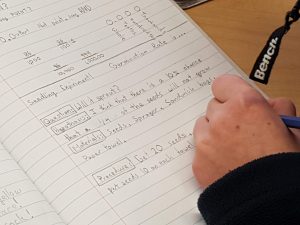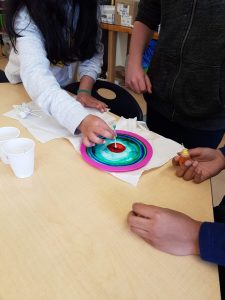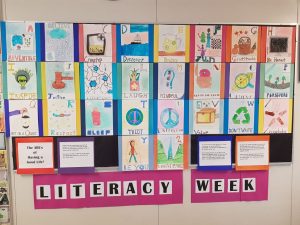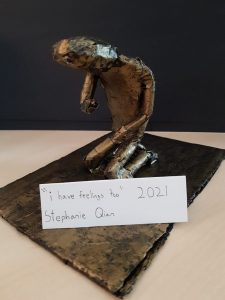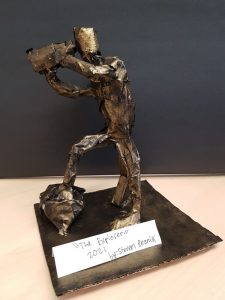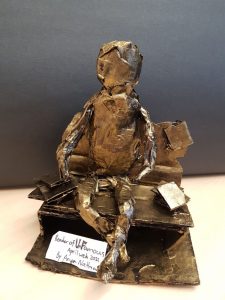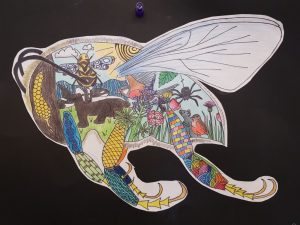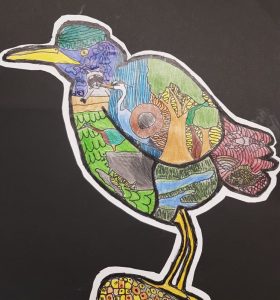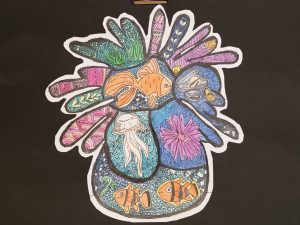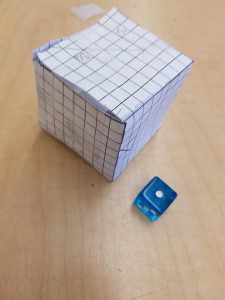Overview Term Three, Spring 2021: Fantastic Work Division 5!
Here is a review of the many things we did during term three!
To tie the big ideas from our curriculum together into a larger, enduring understanding,
we studied subject areas through the lens of universal, conceptual themes.
In mid-February, we began focusing on the concept of POWER
in the unit
COMMUNICATION IS THE KEY!
Our unit focus statement: Being an educated citizen requires reflection and critical thinking about how we communicate and receive information.
What is media and how can we gain personal POWER by being educated about it?
(Socials/Career Education/Language Arts/Critical Thinking/Communication/ADST)
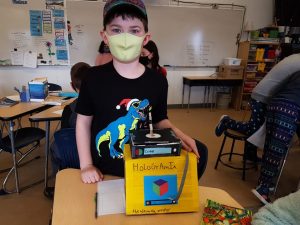 We identified a variety of media forms and looked closely at how their construction, content, advertisements, and reading level were related to their potential audience and purpose. We discussed what it means to be media literate, started taking greater notice of how much time we were spending with media, and discovered how it is present everywhere in our lives. All of this is an important part of being a CRITICAL THINKER and a responsible consumer of media.
We identified a variety of media forms and looked closely at how their construction, content, advertisements, and reading level were related to their potential audience and purpose. We discussed what it means to be media literate, started taking greater notice of how much time we were spending with media, and discovered how it is present everywhere in our lives. All of this is an important part of being a CRITICAL THINKER and a responsible consumer of media.
We compared the outside appearance of cereal packages, looking at how companies market products to children with bright colours, cool characters, games, and other gimmicks. Then we made some sample cereal boxes of our own!
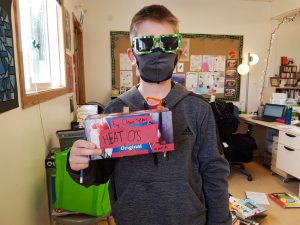 We looked at media advertisements to see what kinds of gimmicks were being used to make us want to buy products. We played games on the Canadian Media Smarts Literacy 101 website together to practice recognizing gimmicks in both print ads and commercials. To show our understandings, we created our own products to sell in a live commercial! We had a wide range of interesting things to sell, complete with catchy brand names, jingles, and slogans to appeal to the consumer.
We looked at media advertisements to see what kinds of gimmicks were being used to make us want to buy products. We played games on the Canadian Media Smarts Literacy 101 website together to practice recognizing gimmicks in both print ads and commercials. To show our understandings, we created our own products to sell in a live commercial! We had a wide range of interesting things to sell, complete with catchy brand names, jingles, and slogans to appeal to the consumer.
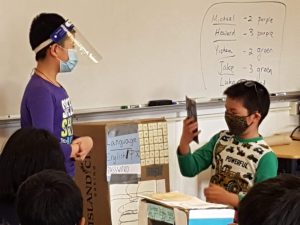 We became more aware of how to search for information online, avoiding commercial websites and looking for reliable sources not full of advertisements or false information. We discussed digital citizenship, learning how online games and social media collect personal information about us while we are having fun online. We played the game Data Defenders to practice NOT giving our information away, keeping our identities safe.
We became more aware of how to search for information online, avoiding commercial websites and looking for reliable sources not full of advertisements or false information. We discussed digital citizenship, learning how online games and social media collect personal information about us while we are having fun online. We played the game Data Defenders to practice NOT giving our information away, keeping our identities safe.
We also learned about what media reports look and sound like. Theresa Lalonde, a production manager for the CBC and teacher of journalism at BCIT, did a virtual visit with us to explain what it is like to work in journalism, and how journalists have POWER through their ability to deliver important information to the public that can help citizens be informed, make good decisions, and be able to advocate for themselves.
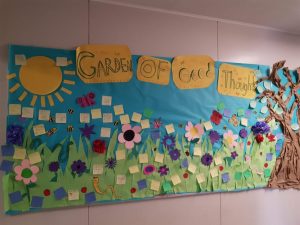 As part of language arts, we learned how a news article is written, and we watched television news broadcasts to see what tone and format is used to deliver information through visual media.
As part of language arts, we learned how a news article is written, and we watched television news broadcasts to see what tone and format is used to deliver information through visual media.
We participated in an editors meeting, in which each of us chose a Suncrest-related topic to report on, either in print or broadcast media, for the Suncrest Sun News. There were interesting reports on nature around Suncrest, the problems with pencil waste at school, school design, cloakroom space, the new daycare building, Literacy Week activities, and more!
How do we communicate scientific ideas and discoveries?
The POWER of careful observation and documentation!
(Science, Language Arts, Critical Thinking, Communication)
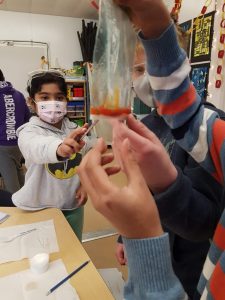 Over the course of this unit, we participated in a wide variety of fun experiments, so we could discuss and apply the scientific method, critical thinking, excellent documentation, and careful observation. We talked about the POWER of careful documentation for communicating and developing scientific ideas, especially if you want to prove your discoveries and further your research.
Over the course of this unit, we participated in a wide variety of fun experiments, so we could discuss and apply the scientific method, critical thinking, excellent documentation, and careful observation. We talked about the POWER of careful documentation for communicating and developing scientific ideas, especially if you want to prove your discoveries and further your research.
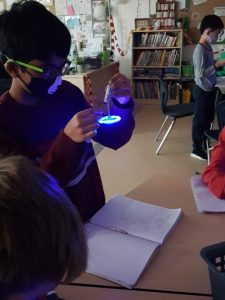 Through an exciting lab in which we changed one substance into another, making limestone, we had the opportunity to discuss physical versus chemical change; acids and bases; natural substances such as turmeric which serve as pH indicators; endothermic and exothermic reactions; and how chemical symbols are used to represent a chemical reaction. Plus we made a bag blow up with gas and it was very exciting!!
Through an exciting lab in which we changed one substance into another, making limestone, we had the opportunity to discuss physical versus chemical change; acids and bases; natural substances such as turmeric which serve as pH indicators; endothermic and exothermic reactions; and how chemical symbols are used to represent a chemical reaction. Plus we made a bag blow up with gas and it was very exciting!!
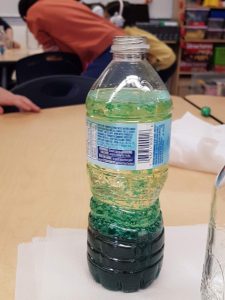 We also talked about density and how temperature affects chemical reactions as we built our own mini lava lamps with water bottles, food colouring, oil, water, and Alka Seltzer. Everyone enjoyed making mini LED light spinners, as we experimented with the Lorentz force and making electric circuits.
We also talked about density and how temperature affects chemical reactions as we built our own mini lava lamps with water bottles, food colouring, oil, water, and Alka Seltzer. Everyone enjoyed making mini LED light spinners, as we experimented with the Lorentz force and making electric circuits.
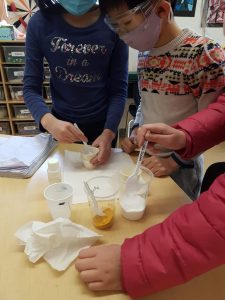 There were more experiments, but the important part is that each one was documented with the scientific method. How do you make a good question to start your research? How do you document observations? How do you write a conclusion with more questions to drive future research?
There were more experiments, but the important part is that each one was documented with the scientific method. How do you make a good question to start your research? How do you document observations? How do you write a conclusion with more questions to drive future research?
Each student then chose an experiment of their own to do and to document. Many chose to do something related to the primary research required for their independent projects. We shared some of the experiments in class, as well as on our e-portfolios.
How are numbers used to communicate ideas in media?
(Math, Critical Thinking, Social Studies)
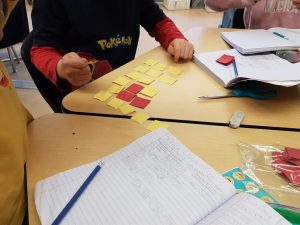 Numbers and data are often thrown into media reports to communicate ideas, and as consumers of media, we need to be critical thinkers about what those numbers mean. It often requires a stronger understanding of what is called proportional reasoning.
Numbers and data are often thrown into media reports to communicate ideas, and as consumers of media, we need to be critical thinkers about what those numbers mean. It often requires a stronger understanding of what is called proportional reasoning.
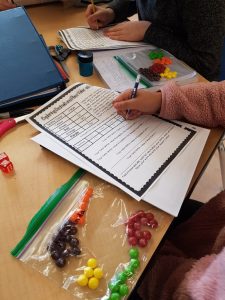 We analyzed news articles on a variety of topics to see how math, particularly graphs, fractions, decimals, and percentages, are used to communicate ideas. If you see numbers, does that mean the information you see is automatically FACT and not someone’s OPINION?
We analyzed news articles on a variety of topics to see how math, particularly graphs, fractions, decimals, and percentages, are used to communicate ideas. If you see numbers, does that mean the information you see is automatically FACT and not someone’s OPINION?
Continuing our work with Carole Fullerton’s Proportional Reasoning, as well as other math resources and games such as SKITTLES MATH, we went deeper into fractions, decimals, and percentages. We were also encouraged to “use the numbers” when making our own news reports, using data to back up our reporting.
Communication, collaboration, and personal awareness give us POWER to make change in our lives: (Communication, PE and Health, Fine Arts)
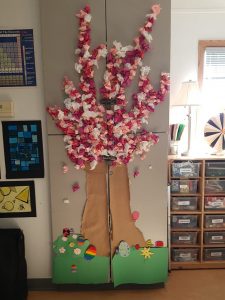 We continued to have our class meetings, which were important opportunities to express ideas and solve problems. One example is how we independently planned our own class Chinese New Year, Valentine’s Day, and Spring decorations, including crafting a lovely cherry blossom tree for all to enjoy.
We continued to have our class meetings, which were important opportunities to express ideas and solve problems. One example is how we independently planned our own class Chinese New Year, Valentine’s Day, and Spring decorations, including crafting a lovely cherry blossom tree for all to enjoy.
We also talked about breathing and mindfulness, taking time to discuss how to find balance, take breaks, and be aware of our mental health. This involved walks outside and active run-around time outdoors.
As part of Literacy Week and our discussions about how mindfulness and gratitude help our health, we created the ABCs of Life, an alphabet of beautiful watercolour pictures with advice about how to live the best life.
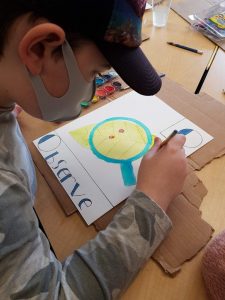 To help us better understand how our bodies can communicate ideas, we also did movement and drama lessons about how to create different characters or ideas with our bodies. We explored how the body communicates so much beyond words. We found “neutral” positions in our bodies, and then we gradually added layers of movement. We moved at different levels, high, medium, and low. We led with different parts of our bodies. We walked and moved in different kinds of lines like wavy, zig zag, and straight.
To help us better understand how our bodies can communicate ideas, we also did movement and drama lessons about how to create different characters or ideas with our bodies. We explored how the body communicates so much beyond words. We found “neutral” positions in our bodies, and then we gradually added layers of movement. We moved at different levels, high, medium, and low. We led with different parts of our bodies. We walked and moved in different kinds of lines like wavy, zig zag, and straight.
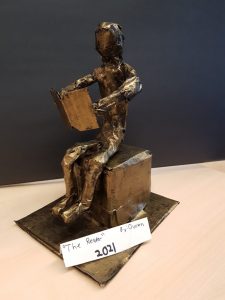 We also explored shape and form through sculpture in art. We went over the history of sculpture and how it, too, is a form of media, communicating a message. Each person then created their own sculpture out of steel wire, masking tape, newspaper, and bronze acrylic paint. It was a longer project, but the result was well worth it, as our Museum of Sculptures shows!
We also explored shape and form through sculpture in art. We went over the history of sculpture and how it, too, is a form of media, communicating a message. Each person then created their own sculpture out of steel wire, masking tape, newspaper, and bronze acrylic paint. It was a longer project, but the result was well worth it, as our Museum of Sculptures shows!
In April, we began focusing on the concept of CONNECTION
in our unit
THE NATURE CONNECTION.
Unit focus statement:
Human beings impact and rely upon the balance of nature’s interdependent systems.
Unpacking the concept of CONNECTION — What does it mean?
(Science, Socials, Social Responsibility)
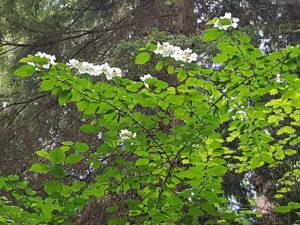 What does connection mean, and where do we see it? We began with class discussions around what we connect to personally, how we are connected to the community, and how we are connected to the world.
What does connection mean, and where do we see it? We began with class discussions around what we connect to personally, how we are connected to the community, and how we are connected to the world.
How are we connected to our natural environment? First we talked about what we can find in our natural environment and had fun deciding what is abiotic and biotic. IS a virus alive or not?? At the end of the day, some of this is still up for debate!
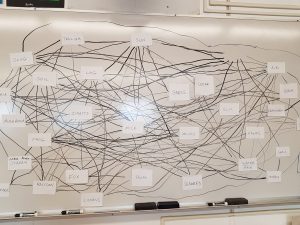 We watched Planet Earth: Pole to Pole, and discussed the variety of biomes, ecosystems, and amazing organisms that exist across the planet. Each student was given a card with an organism within our local ecosystems, and after doing quick research, placed it within the food web and cycles of our world. Further reading was done on how parts of nature are connected through food chains, as well as the carbon, nitrogen, phosphorus, and water cycles.
We watched Planet Earth: Pole to Pole, and discussed the variety of biomes, ecosystems, and amazing organisms that exist across the planet. Each student was given a card with an organism within our local ecosystems, and after doing quick research, placed it within the food web and cycles of our world. Further reading was done on how parts of nature are connected through food chains, as well as the carbon, nitrogen, phosphorus, and water cycles.
Making connections to tell the story of life!
(Science, Critical Thinking)
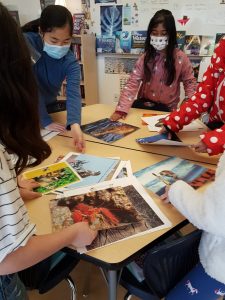 To better understand how organisms in our ecosystems are connected, we investigated taxonomy. Scientists use taxonomy to classify life according to specific features, adaptations, reproductive and survival behaviours, and appearance.
To better understand how organisms in our ecosystems are connected, we investigated taxonomy. Scientists use taxonomy to classify life according to specific features, adaptations, reproductive and survival behaviours, and appearance.
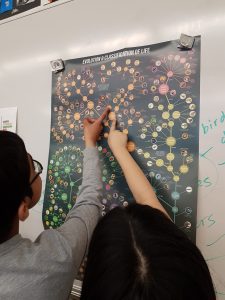 Before we looked at the official chart, we did our own hands-on sorting, and small groups were given piles of pictures of animals and organisms to organize into specific groups according to characteristics. We had lots of great debate! Then we had an opportunity to learn about the classification system, picking an animal and learning about their kingdom, phylum, family, class, genus, and official Latin species name.
Before we looked at the official chart, we did our own hands-on sorting, and small groups were given piles of pictures of animals and organisms to organize into specific groups according to characteristics. We had lots of great debate! Then we had an opportunity to learn about the classification system, picking an animal and learning about their kingdom, phylum, family, class, genus, and official Latin species name.
How do we become more connected to and observant of the nature around us?
(Science, Socials, Critical Thinking, Fine Arts, Physical Health Education)
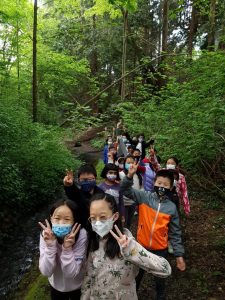 As we looked at how we are connected to other organisms, we developed a better understanding of place and the nature directly around us. Through the Burnaby-New West Walking Challenge and SFU Walking Curriculum, we took regular walks outside, during which we used the Walking Curriculum, a series of activities designed to help us become more observant, mindful, and thoughtful about what we are seeing and experiencing while we walk. We all walked a lot of minutes, recording time from school and at home with our families!
As we looked at how we are connected to other organisms, we developed a better understanding of place and the nature directly around us. Through the Burnaby-New West Walking Challenge and SFU Walking Curriculum, we took regular walks outside, during which we used the Walking Curriculum, a series of activities designed to help us become more observant, mindful, and thoughtful about what we are seeing and experiencing while we walk. We all walked a lot of minutes, recording time from school and at home with our families!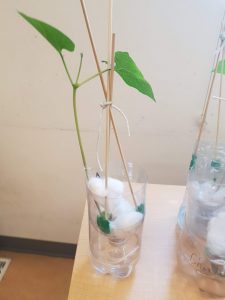
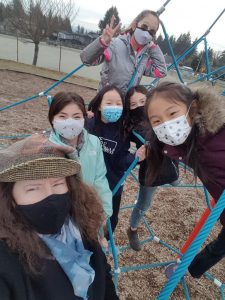 We discussed how this mindfulness and being outside was helping improve both our physical and mental health! These exercises also helped us practice being super-observers to help with science investigations in the future.
We discussed how this mindfulness and being outside was helping improve both our physical and mental health! These exercises also helped us practice being super-observers to help with science investigations in the future.
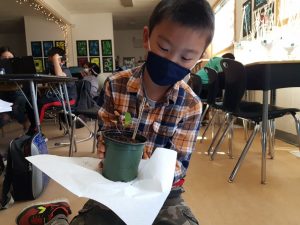 We also connected with nature by growing seedlings of radishes and spinach and getting our hands messy in the dirt! We experimented with growing beans through aquaponics, and it was amazing some of the beans grew without any soil at all! These activities gave us a taste of mindful, fun activities connected to nature that can bring us calm and well being.
We also connected with nature by growing seedlings of radishes and spinach and getting our hands messy in the dirt! We experimented with growing beans through aquaponics, and it was amazing some of the beans grew without any soil at all! These activities gave us a taste of mindful, fun activities connected to nature that can bring us calm and well being.
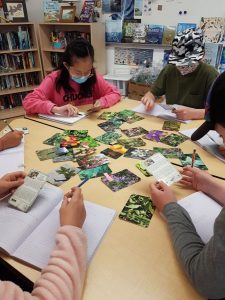
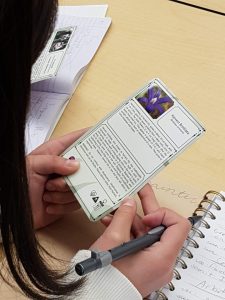 We used loupes to look carefully at natural specimens and plants. We talked about how to observe shape and line quality first when trying to carefully draw specimens, and we did several still-life, up-close drawings to record outside findings.
We used loupes to look carefully at natural specimens and plants. We talked about how to observe shape and line quality first when trying to carefully draw specimens, and we did several still-life, up-close drawings to record outside findings.
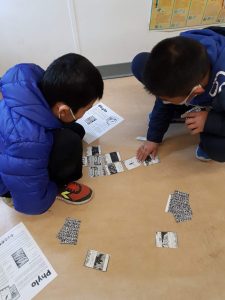 We learned Indigenous names and uses for local plants and trees, identified invasive plants that are not part of the ecosystem, and discussed local animals and habitats. We played the Phylo Card Game, which helped us learn how the health of organisms is connected to available habitat and human actions. We watched episodes of David Suzuki’s The Nature of Things, and particularly enjoyed learning about the important role fungi have played in the development of our planet!
We learned Indigenous names and uses for local plants and trees, identified invasive plants that are not part of the ecosystem, and discussed local animals and habitats. We played the Phylo Card Game, which helped us learn how the health of organisms is connected to available habitat and human actions. We watched episodes of David Suzuki’s The Nature of Things, and particularly enjoyed learning about the important role fungi have played in the development of our planet!
Finally, we talked about extinct, endangered, and protected organisms in B.C. Everyone chose a unique organism from BC they didn’t know anything about, then researched its biome, ecosystem, habitat, taxonomy, adaptations, behaviours, and connection to First Peoples stories and art. We presented our findings in a five paragraph essay, as well as through a beautiful piece of art inspired by the works of Oregon artist Sue Coccia.
Becoming Aware of Traditional Indigenous Ecological Knowledge:
(Socials, Science, Indigenous Education)
 As we developed observation skills that help with scientific investigations, we also asked, “What is science?” We discussed the difference between western science and the traditional ecological knowledge of First Peoples. Ms. D read some of Braiding Sweetgrass, which opened a discussion on what is really biotic? In western science we classify things into abiotic and biotic; whereas in Indigenous cultures, many abiotic forms are alive, given each form plays a specific role in the ecosystem and was placed there for a reason. We also read My Elders Tell Me, a great story about how a group of First Nations children learned skills for daily survival and respect for the environment directly from their elders. We watched videos and read about how First Peoples are working in partnership with scientists to manage local waterways, and how Indigenous knowledge provides careful observations from years and years of living on the land. We learned about clam gardens and how First Peoples managed marine food systems, so we can better protect food sources today. Overall, we had great discussions about our connection to the land and the value of traditional knowledge!
As we developed observation skills that help with scientific investigations, we also asked, “What is science?” We discussed the difference between western science and the traditional ecological knowledge of First Peoples. Ms. D read some of Braiding Sweetgrass, which opened a discussion on what is really biotic? In western science we classify things into abiotic and biotic; whereas in Indigenous cultures, many abiotic forms are alive, given each form plays a specific role in the ecosystem and was placed there for a reason. We also read My Elders Tell Me, a great story about how a group of First Nations children learned skills for daily survival and respect for the environment directly from their elders. We watched videos and read about how First Peoples are working in partnership with scientists to manage local waterways, and how Indigenous knowledge provides careful observations from years and years of living on the land. We learned about clam gardens and how First Peoples managed marine food systems, so we can better protect food sources today. Overall, we had great discussions about our connection to the land and the value of traditional knowledge!
How are our actions connected to the health of the environment?
(Social Studies, Science, Social Responsibility, Personal Awareness)
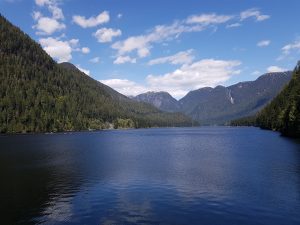 Part of being better connected to nature is better understanding our role in keeping the environment we depend upon healthy! We had a variety of amazing virtual field trips this unit to help us get out in the community and to discuss social responsibility to our planet.
Part of being better connected to nature is better understanding our role in keeping the environment we depend upon healthy! We had a variety of amazing virtual field trips this unit to help us get out in the community and to discuss social responsibility to our planet.
First, we had a virtual trip to the beautiful GVRD Lower Seymour Watershed, learning about the water cycle, where our water comes from, and how the ecosystem of the mountains plays a role in providing us with such clean water.
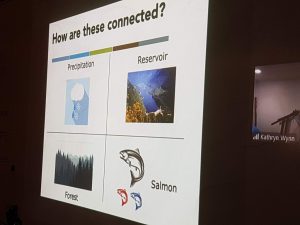 In another virtual presentation from the GREEN Organization in Vancouver, we learned how we can conserve and protect our precious natural resource of water!
In another virtual presentation from the GREEN Organization in Vancouver, we learned how we can conserve and protect our precious natural resource of water!
The GREEN organization came back a second time to talk with us about how much stuff we use, and what we can do to reduce our consumption of stuff to reduce our impact on the environment, to prevent waste going to the landfill, and to ensure we conserve our natural resources.
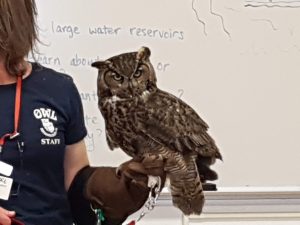 We had a virtual presentation from The O.W.L. Sanctuary in Delta, who shared how pollution, rodenticides, and housing development are impacting local ecosystems and birds of prey. We visited with some raptors and discussed how we can help protect these amazing creatures!
We had a virtual presentation from The O.W.L. Sanctuary in Delta, who shared how pollution, rodenticides, and housing development are impacting local ecosystems and birds of prey. We visited with some raptors and discussed how we can help protect these amazing creatures!
Through the Stanley Park Ecology Society we learned about cute river otters! After the presentation, we better understood the difference between river and sea otters, as well as how river otters are an important species for our ecosystem that can be seen throughout the Salish Sea.
We enjoyed hearing from the Bamfield Science Centre research education team in our session on Sensational Seaweeds and Oceanography! They gave us a taste of the research they do on ocean health, the tools they use to collect data, and the many species of green, red, and brown seaweed you can find on the Pacific coast. It was amazing to see pictures of the open ocean from the west side of Vancouver Island near Uclulet.
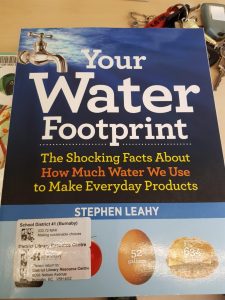 Finally, we talked about global warming and climate change, listening to the inspirational Bill Nye explain the science and the possible problems that will occur. We read articles and watched videos about desertification, pollution, and other human-made disasters in the environment. Everyone had an opportunity to also read about how people are solving these problems, through the Orca Footprints book series on topics such as ocean health, landfills, future agriculture, and green transportation, as well as other resources from our libraries.
Finally, we talked about global warming and climate change, listening to the inspirational Bill Nye explain the science and the possible problems that will occur. We read articles and watched videos about desertification, pollution, and other human-made disasters in the environment. Everyone had an opportunity to also read about how people are solving these problems, through the Orca Footprints book series on topics such as ocean health, landfills, future agriculture, and green transportation, as well as other resources from our libraries.
Finding Reading Connections & Using Literary Devices
(Language Arts, Fine Arts, Critical Thinking and Questioning)
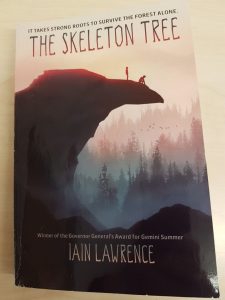 Ms. D read The Skeleton Tree, while everyone followed along and took notes in “readminders” designed to collect thoughts about new vocabulary, key details, connections, or questions while reading. This involved metacognition — becoming aware of how we think so we can improve our critical thinking! The book tells the story of two boys stranded on the Alaska coast and how they survive.
Ms. D read The Skeleton Tree, while everyone followed along and took notes in “readminders” designed to collect thoughts about new vocabulary, key details, connections, or questions while reading. This involved metacognition — becoming aware of how we think so we can improve our critical thinking! The book tells the story of two boys stranded on the Alaska coast and how they survive.
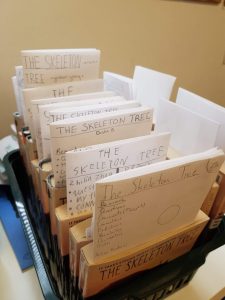 We created comprehension questions of greater depth using Question and Response (QAR), and students explained this in their e-port entries about the book. It was an exciting tale that connected well to our unit!
We created comprehension questions of greater depth using Question and Response (QAR), and students explained this in their e-port entries about the book. It was an exciting tale that connected well to our unit!
We also explored how to use figurative language, literary devices, and different poetry formats to express our feelings about CONNECTION to nature. We did writing exercises from the book Rip the Page to further develop our descriptive vocabulary, and to help us with written output and creative thinking. We learned about alliteration, personification, metaphor, and similes, as well as poetic forms such as haikus, hexaduads, couplets, tankas, and free verse. After we researched a BC organism, we wrote one poem from its point of view, anthropomorphizing the natural life around our home. Everyone displayed their poems in a creative ZINE, which is a small, reproducible magazine made to share ideas with others!
Connection Between Nature and Math!
(Math, Art, Science, Applied Design)
 Our main focus was geometry and math related to patterns in nature. Ms. D read sections of books about nature and math, such as The Language of the Universe. During our ventures outside, we looked for examples of these patterns in the nature around us. We discussed Fibonacci, the Golden Mean, and Fractals found in plants, wave patterns, our bodies, and bee genetics!
Our main focus was geometry and math related to patterns in nature. Ms. D read sections of books about nature and math, such as The Language of the Universe. During our ventures outside, we looked for examples of these patterns in the nature around us. We discussed Fibonacci, the Golden Mean, and Fractals found in plants, wave patterns, our bodies, and bee genetics!
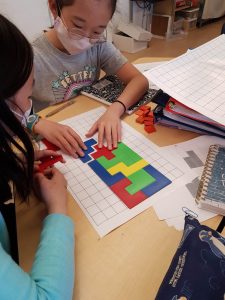 We had a great time discovering pentominoes, which are shapes formed by combining five 2D cubes together. We worked together to see how many different combinations of cubes we could make that would form unique pentominoes, and there are 12! We had to use the math concepts of rotation, translation, and reflection to ensure we did not have congruent shapes and had indeed created something new. We played several fun games to work with visual-spatial patterns!
We had a great time discovering pentominoes, which are shapes formed by combining five 2D cubes together. We worked together to see how many different combinations of cubes we could make that would form unique pentominoes, and there are 12! We had to use the math concepts of rotation, translation, and reflection to ensure we did not have congruent shapes and had indeed created something new. We played several fun games to work with visual-spatial patterns!
Students also completed activities about measurement, area, perimeter, shape classification, volume, angles, multiplication, division, fractions, and decimals through applied math problems about nature in the books Animal Math and Planet Earth Math, as well as Geometry and Measurement for Intermediate Grades.
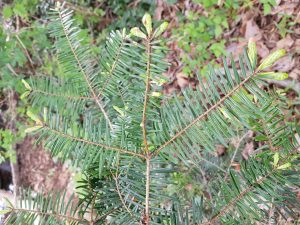 We also watched a video series called Doodling in Math Class about nature math, and made our own, portable “angle-a-trons” for 137.5 degrees to try outside on plants, confirming leaves grow in specific, consistent angle patterns to maximize light exposure.
We also watched a video series called Doodling in Math Class about nature math, and made our own, portable “angle-a-trons” for 137.5 degrees to try outside on plants, confirming leaves grow in specific, consistent angle patterns to maximize light exposure.
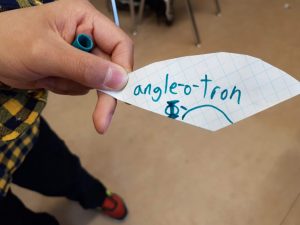 Others enjoyed artistic parts of math, using compasses and protractors to create complicated patterns from This is Not a Math Book.
Others enjoyed artistic parts of math, using compasses and protractors to create complicated patterns from This is Not a Math Book.
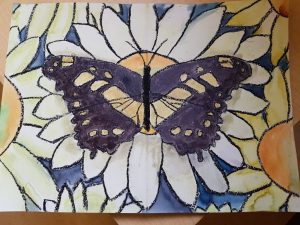 We found a lot of symmetry in nature, and we created careful drawings of butterflies, using pastel and watercolor to make balanced compositions. We also had an opportunity to make mandala dot art rocks, which was a practice in patience, perseverance, and mindful art.
We found a lot of symmetry in nature, and we created careful drawings of butterflies, using pastel and watercolor to make balanced compositions. We also had an opportunity to make mandala dot art rocks, which was a practice in patience, perseverance, and mindful art.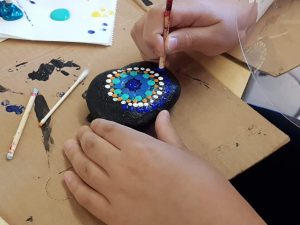
Some students took on extra challenges such as Applied Math in Oceans and Space, from the EPIC website, or doing area challenges in the book Area Mazes 2.
Finally, we used our discussion of geometry and measurement to create scale models of objects so we would understand how to make a scale model for applied design.
We imagined what the empty grass space in the intermediate playground could be like. Using nature math, knowledge of indigenous plants, and our outside observations during the unit, we made scale models of a proposed nature space for relaxing, learning, and taking a break outdoors. Students were asked to incorporate mathematics and unique natural elements into the design. Thank you everyone for your creative results!
French Weather Conversation!
(Core French, Drama, Language Arts, Creative Thinking)
We integrated conversations about the outdoors into our French learning, as well, by focusing on communicating the weather. Everyone chose a partner, learned basic weather phrases, and then created a crazy dialogue with costumes to represent the weather in front of the class.
Independent Project!
(Socials, Science, Critical Thinking, Career Education, and Personal Awareness)
 By February, most students had selected topics for independent study. They were allowed to select any topic as long as it was something they sincerely cared about!
By February, most students had selected topics for independent study. They were allowed to select any topic as long as it was something they sincerely cared about!
During each project this year, we worked on the specific curricular competencies and skills to help with a successful independent inquiry.
These skills can be found in almost every aspect of the curriculum, including career education, social studies, language arts, science, fine arts, and applied design. Here is a quick summary:
- Understanding passions and making a commitment to pursue a personal interest
- Project management, goal setting, and meeting deadlines
- Self-management as they monitor their time during open work periods
- Asking questions that further an inquiry, including open and closed questions
- Documenting and organizing research through notes and a bibliography
- Searching online effectively, including finding reliable and safe resources
- Using critical thinking to analyze resources and summarize findings
- Communicating findings in writing and through public speaking
- Applying creative thinking by sharing results through a variety of media
We had a wide variety of topics including things like hummingbirds, arduino, autism, stars, galaxies, carbon footprint, the Grand Canyon, bird evolution, future transportation, the circulatory system, and more! As we finish, the digital versions of their projects will be posted on the Independent Projects tab of the class blog’s main menu.
We hope this provides you a snapshot of all the great learning Division 5 did in term three! Please see individual e-portfolios for more information and photos of individual projects and thinking about the units!

